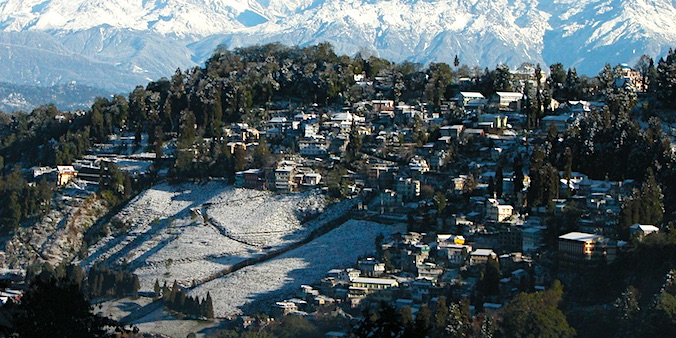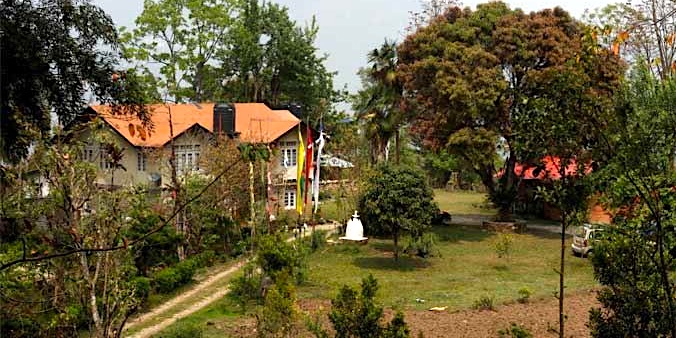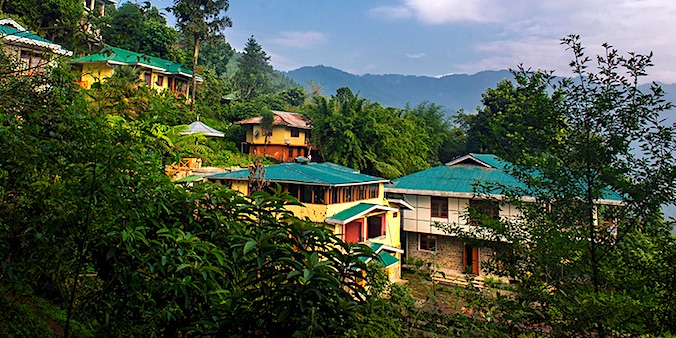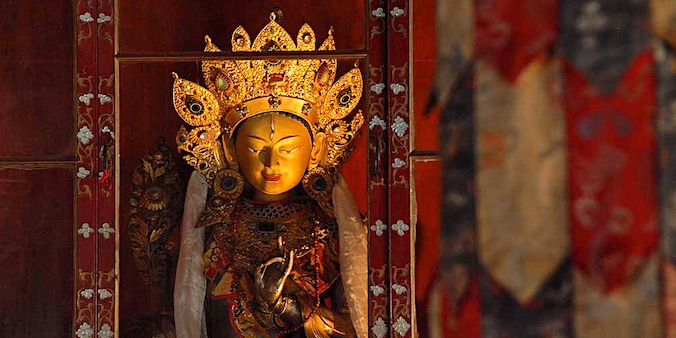BICYCLE TOUR DARJEELING and SIKKIM
Tour - 14 days/ 12 days bicycling
About Darjeeling & SIKKIM
Sikkim and neighboring Darjeeling have a lot to offer to mountain lovers, aficionados of Buddhist culture and trekkers. Wedged in between Nepal, Bhutan and Tibet – but part of India – this region shares a lot with these areas.
Darjeeling, situated at 2040m, has the typical atmosphere of Indian hill stations. It was the former summer capital of British India, and has preserved much of the old-world charm. Darjeeling is world-famous for its tea, which is grown in extensive tea estates that clad the surrounding slopes. Being very close to the tallest mountains on earth, especially number 3, the Kangchenjunga (8586m) it also boasts great views from most hotel windows.
It’s next-door neighbour Sikkim – of which it used to be part – is a gem of cultural and natural diversity. Until 1974 Sikkim was an independent kingdom, now it is part of India. It is home to different Himalayan peoples, most from Nepali descent or originating from Tibetan and Bhutan, such as the Bhutias who brought Buddhism to the area four centuries ago. Thanks to them Sikkim boasts of colorful Buddhist monasteries and Buddhist festivals. The Lepcha’s, until a few decennia ago forest-dwelling animists, hold a unique culture that the Sikkimese government is trying to preserve.
Read more…Read less…
Region
Darjeeling & Sikkim
(India)
Best Time
March-April &
Oct-Dec
No. Of Days
14 days, 12 days bicycle trek
Trip Character
Bicycle tour
Sleeping Altitude
1620 - 2130 m
Bicycle Trek Character
Homestays & guesthouses
Bicycle tour: level 3
Price
INR XXX/ $ XXX
ABOUT THIS TOUR
On this tour, you’ll fly from Delhi to Bagdogra, south of Sikkim, and then to nearby Siliguri, where your bicycles will be waiting. From here to Darjeeling, the tea capital of India endowed with a lot of old world charm.
This mountain biking itinerary offers an exclusive experience of Sikkim and Darjeeling, its people and mountains and its fascinating flora and fauna. Most of the biking is done on remote roads, avoiding dense traffic routes, that wind their way through the lush countryside and forests. On this itinerary you will get a very good overview of the land and people of Sikkim, its Buddhist monasteries, different tribal cultures. Occasionally you will get very good views of the Khangchenjunga (8485 m) and other Himalayan peaks. Your accommodation is a mix of pleasant homestays, ‘different’ ecoresorts and comfortable hotels.
YOUR custom-made TRIP
The tour described here, as well as the other ones on our website, are mainly meant as suggestions. We would be happy to offer you a travel proposal that fully meets your personal demands and expectations. That means that you choose where you want to go, what level of accommodation and type of transport you want and what activities you prefer.
Please let yourself be inspired by this and other trips on our website and then drop us a line (or call us) to explain your travel wishes. We will be happy to help you put together the perfect trip. You can reach us over e-mail, Messenger, Whatsapp or mobile phone.
EXTENSIONS & VARIATIONS
Apart from the tour as described here, you could consider the following add-ons and changes:
- Stay longer in Darjeeling, Gangtok or one of the smaller hamlets that you pass through on the way. Darjeeling and Gangtok have a lot to offer in terms of local sights, such as monasteries and temples, handicraft markets, shopping and pleasant cafes. The smaller places, such as Kewzing and Yuksum, is where you can meet the locals and learn about their culture.
- Travel further north – which means: higher – into the Sikkimese Himalayas and explore the isolated ‘Tibetan’ hamlets of Lachung and Lachen. See here.
- Add a walking trek to your programme to get even higher into the Himalayas and enjoy stupendous vistas of Mt. Kangchenjunga. We highly recommend the Shingalila Ridge trek.
- If you’re into really long bicycle tours, we can organise a combination of Sikkim, Assam and Arunachal Pradesh. Or, combine your tour in Sikkim with exploring neighbouring Nepal or Bhutan. Ask us for suggestions.
Route Map
ITINERARY
-
.fa-info {color: #1146a9;}.fa-info:hover {color: #387dff;}Day 1: Delhi ✈︎ Bagdogra & drive to Siliguri (30 min drive)
The flight to Bagdogra takes less than 2 h and, in clear weather, affords wonderful views of the Himalayas, including Mt. Everest (8848m) and Kangchenjunga (8568m). At the airport our guide and driver await you, and will take you to nearby Siliguri, a major city in the Bengali plains. Here you can assemble your bikes (assuming you bring your own bikes). If you want you can do an introductory ride in the flat surroundings of Siliguri. Overnight in a good hotel. Altitude 120m. -
Day 2: Siliguri – Dudhia – Sumendu Lake (biking 46.5 km, +1635m, -155m)
This first day of biking begins with a 23 km ride over almost flat terrain to the Dudhia bridge (300m) just below the foothills of the Himalayas. Soon after, the road rises to around 1000m and further on there is a final climb to the beautiful Sumenda Lake near Mirik. On the way you will pass acres of tea plantations as this is a core tea growing area.
Overnight at a nice hotel with beautiful views down to the lake. Altitude 120 → 1620m.

-
Day 3: Sumendu Lake - Darjeeling (biking 38.5 km, +1590m, -1075m)
Today you’ll cycle north on a local, mostly slowly rising road, and partly right along the Nepalese border. Then the road turns east, enters a large forest, and finally reaches the main north road at Ghoom, the site of an old Buddhist monastery. A quiet road takes you in 7 km to Darjeeling, where great mountain views
from your hotel room await you. Altitude 1620 → 1065 → 2130m.

-
Day 4: At Darjeeling
Today you can explore he many sights of Darjeeling, on foot, bicycle or by car. Altitude 2130m.
-
Day 5: Darjeeling - Jorethang - Pelling (biking 72,5 km, +2360m, -2540m)
A steady descent takes you to Jorethang, where you enter Sikkim. Here, the more serious work starts. For 27 km you follow the west bank of the Rangit River, very gradually climbing to Legship. From here to Pelling it is a tough climb (about 1400 m in 23 km). It’s entirely up to you whether you want to take
on this final challenge (or skip it by riding the car). Altitude 2350 → 315 → 2050 → 1930m.

-
Day 6: Pelling – Pemayangtse - Kechopalri Lake – Yuksom (biking 55 km, +1995m, -2195m)
After an extended visit to the famous Pemayangtse Monastery, we continue to Yuksom, the ancient capital of Sikkim and trailhead for treks towards Khangchenjunga. On the way, we take a side trip to the beautiful Khecheopalri Lake,
perhaps the holiest lake in Sikkim. Overnight stay in Yuksom. Altitude 1930 → 2070 → 1160 → 1825 → 1110 → 1750m.

-
Day 7: Yuksom - Tashiding Monastery - bridge - Kewzing (biking 50 km, +1775m, -1890m)
The first part of today’s ride, from Yuksom to Tashiding, is overall downhill, though interupted by two shorter and one longer climb. We’ll visit the spectacularly located Tashiding Monastery, built in 1641 by a famous sage. After crossing the Rangit River over a hanging bridge (650m), and climbing 1000m, we reach Kewzing, a typical quiet Bhutia village set against a backdrop of magnificent mountains.
Overnight in a simple, charming local homestay. Altitude 1750 → 1350 → 1605→ 1200 → 1460 → 655 → 800 → 705 → 1650m.

-
Day 8: At Kewzing, daytrip (biking 38 km, +1150m, -1155m)
Today we don’t move base. We’ll do some easy biking and visit the Buddha Park near Ravangla with an iconic 40m high statue, and the nearby Ralang Monastery with an extensive collection of paintings and thangkas.
The rest of the day you can just relax in the village. Altitude 1650 → 2055 → 350 → 1650m

-
Day 9: Kewzing - Ravangla - Damthang - bridge - Rumtek (biking 86,1 km, +2440m, -2405m)
The 60 km route up to the bridge over the Teesta River (380m) is mostly coasting downhill. From there it is 14 km steep climbing to about 1450m and then 10 km with only minor ascents and descents until Rumtek. You can visit Rumtek Gompa, Sikkim’s finest monastery, today or tomorrow.Overnight stay in a very pleasant family-run ecoresort. Altitude 1650 → 380→ 1580m

-
Day 10: Rumtek - Ranka Monastery - Gangtok (biking 29,5 km, +870m, -875m)
Our first destination today is Ranka, a relatively new monastery, but its location in a forested area is beautiful. From there we continue to Gangtok, Sikkim’s quaint, but relatively hip capital. In the afternoon/evening, stroll around M.G. Marg, the heart of Gangtok.Overnight in good hotel in Gangtok. Altitude 1650 → 1235→ 1320 → 1250 → 1400 → 1195 → 1650m.

-
Day 11: In Gangtok
No biking today, at least not if you don’t want to. Early morning, we can witness a spectacular sunrise over the Kanchenjunga range from the Tashi View Point near the city. Later, we visit some of the sights, as mentioned in the highlight. Altitude 1650m.
-
Day 12: Gangtok - Rangpo River (biking 68 km. +1560m, -2115m)
Today and tomorrow you'll bicycle down again, in the direction of Kalimpong. Instead of following the regular road, which follows the Rangpo River gorge, you'll navigate smaller, less used mountain roads along small hamlets and over ridges with great views. Today's destination is a small but pleasant
home stay just north of the Rangpo River. Altitude 1620 → 2025 → 1360 → 1560 → 900 → 1100m

-
Day 13: Rangpo River - Kalimpong (biking 68 km. +2200m, -2120m)
After descending to a river, and crossing it, your first climb awaits you. You'll reach the small settlement of Renock. Descending and climbing up again brings you to the hamlet of Pedong, and on an elevated ridge, where you will get very good views to the east and the west, as well as the large town of Kalimpong in the southwest,
your last overnight halt on this trip. Altitude 1100 → 600 → 1205 → 600 → 1835 → 1790 → 1800 → 1180m.

-
Day 14: Kalimpong - Bagdogra ✈︎ Delhi (4 h drive, 2 h flight)
After breakfast the car will take you down to Bagdogra where you check in for the flight to Delhi. It depends on the timing of your international flight whether you will need an overnight stay in Delhi. In the latter case we can arrange this for you.
HIGHLIGHTS OF THIS TOUR

DARJEELING
DARJEELING'S TOY TRAIN


Darjeeling Tea
If there is one legacy of the Brits in India it is tea. Tea estates, tea processing and exporting, and tea drinking. It was long believed that wild tea, Camelia sinensis, only grew in China, but this small woody brush was ‘rediscovered’ by the British in the early 19th century in the jungle of Assam. Camelia sinensis var. assamica had long been used by indigenous people. Large tracts of land were converted into tea gardens and these days Darjeeling (and Assam) tea are known worldwide. There are two kinds of preparation. The black tea that is being dunked in water that just has been boiled is called orthodox. In Indian households and tea stalls the tea is generally boiled for some time with milk and sugar, and sometimes spices. This is called CTC tea. The two kinds of tea require different factory handling, but both have the same Camelia leaves as the starting point.

Yangsum Farmhouse
Pemayangtse Monastery


Teen Taley Eco Resort
Teentaley Eco Resort is not a hotel but, as they say “an organic experience of the real, rural Sikkim.” Here, you stay in cozy bamboo cottages amidst a sprawling landscape garden, with a farmhouse and a private forest where you can go bird watching without leaving the premises. The food is home-grown, organic of course, and dinners are accompanied with the typical Sikkimese tongba – bamboo containers filled with millet beer. As the location, in Rumtek, is close to Gangtok, you can stay here, sleeping in the quiet of the mountains and waking to the birds’ songs, while visiting Sikkim’s capital during the day.
Rumtek Monastery


Gangtok
In Sikkim’s capital Gangtok, the rear neighbours almost always live on another street and hardly anyone has a garden, because the slopes are too steep for that. This also means that the roads are nowhere wide and often clogged. But fortunately most locations in the city can be reached on foot. Pedestrians can use a whole series of footbridges to cross busy roads. Gangtok was also the first city in India to declare its centre a pedestrian area. Here, it is pleasant to stroll and shop and there are numerous ‘hip’ restaurants and cafes. Thanks to the government’s serious approach to environmental problems – a rarity in India – this is also one of India’s cleanest city centres. Interesting places to visit include the flower exhibition – with many varieties of orchids – the Institute of Tibetology, Enchey Gompa and Tashi Viewpoint.










